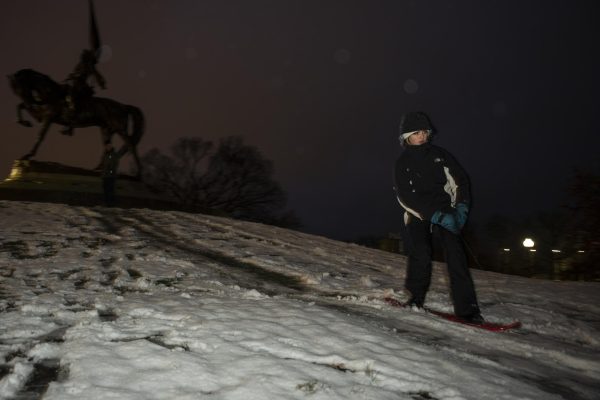Sisters’ role highlighted
February 22, 2010
An antiquated video plays on a loop at the entrance of the “Freedom’s Sisters” exhibit at Washington Park’s DuSable Museum of African American History, next to a striking, multi-paneled black and white photo of female civil rights marchers.
In the video, school children of various races and genders name their heroes. The answers are unsurprising: a fireman, Abraham Lincoln, Martin Luther King Jr. and Superman.
“That’s fine,” the host of the video says softly. “But what about someone like your mom?”
The new exhibit, which runs until April 4, was created to show how many female heroes there are in U.S. history, most of whom have been overlooked, according to the text in the exhibit. In conjunction with the “Freedom’s Sisters” exhibit, the museum collaborated with Macy’s to allow people to nominate a Chicago Freedom Sister.
“I think women have been a bit left out of the history,” said Jocelyn Oates, Columbia professor of Interior Architecture, while exploring the exhibit. “I think it’s really important that their stories be told.”
According to the DuSable Museum Web site, the exhibit was brought to Chicago from Cincinnati to teach visitors about some of the women essential to the civil rights movement.
“Much of our national memory of the civil rights movement is embodied by male figureheads whose visibility in boycotts, legal proceedings and mass demonstrations dominated newspaper and television coverage in the 1950s and ’60s,” the museum’s Web site reads. “Missing from that picture is a group of extraordinary women who, while less prominent in the media, shaped much of the spirit and substance of civil rights in America.”
The “Freedom’s Sisters” exhibit consists of three rooms, each of them filled with tall, wooden, interactive stations about the lives and achievements of 20 black women. The women celebrated by the museum range from the well-known, like Rosa Parks and Harriet Tubman, to those who have almost been forgotten, like Fannie Lou Hamer, who fought for voting rights, or investigative journalist Ida B. Wells-Barnett, who documented the extent of lynching in the early 20th century.
It is Hamer’s words that adorn the back wall of the exhibit, written near the top of a bare maroon wall where they read, “Nobody’s free ’til everybody’s free.”
Passing underneath the phrase on Feb. 13 was a small crowd, made up mostly of black families; mothers taking their sons and daughters through the exhibit.
“I think it’s wonderful to see this history,” said museum patron Brittney Whitfield. “To see it, and have my daughter see it, is amazing.”
Whitfield was visiting the museum with her friend, who also brought her young daughter. As a video recreation of Rosa Parks’ famous arrest played on a television set, the two small children stood captivated, the elder shushing her younger friend when she became distracted.
“To see what she went through is incredible,” Whitfield said of Parks. “Everyone should come and see it.”
The video of Parks, which is activated by stepping on a mat in front of the screen, is just one of many interactive features in the exhibit. Oates said she thought those features made “Freedom’s Sisters” effective.
“I like that you can communicate with every part of the exhibit,” Oates said.
The “Freedom’s Sisters” exhibit was created through collaboration between the Smithsonian Institute Traveling Exhibition Service and the Cincinnati Museum Center.
Unique to Chicago, the “Nominate a Chicago Freedom Sister” contest invites the public to nominate a Chicago woman who “fought for justice and parity,” and who has “historically demonstrated an unbridled commitment to our struggle for equal rights.”
According to Whitfield, the contest is just another tool that can educate people on the important contributions women have made to history.
“I see all types of strong women in here,” she said, gesturing around the exhibit. “As far as documentaries and TV shows, there should be more.”






